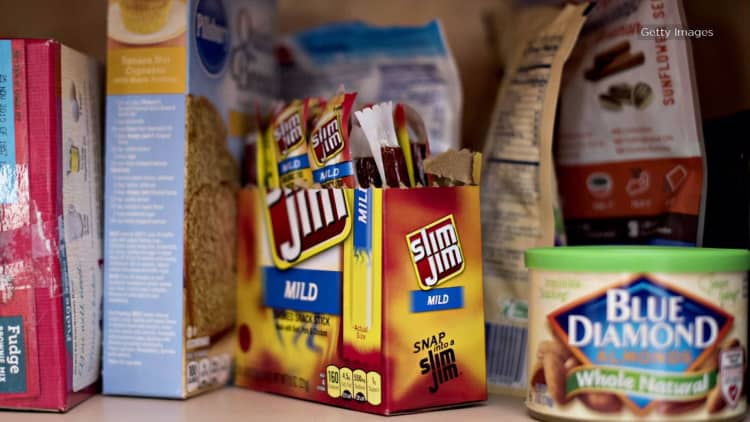
Grass-fed beef. Premium pork. Hormone-free. No artificial colors and flavors.
Wait, you're talking about Slim Jim?
Yes, those meat sticks that evoke childhood memories of gas stations and orange fingers are getting a makeover. Or, as Conagra says, Slim Jim is growing up. The company is releasing Slim Jim Premium Smoked Sticks that are shorter, come in a multiple-serving package and are available in trendy flavors like Thai Style Chili.
"Maybe you've loved Slim Jim and its bold flavors and great attitude as a teen, but maybe in the office of your first job, eating a stick of a Slim Jim like you're peeling a banana in front of the senior management, maybe doesn't make you feel like you want to," said Bob Nolan, Conagra's senior vice president of insight and analytics.
Slim Jim is the latest of a growing number of longtime brands that are being reworked by their manufacturers. Sluggish sales, shifting consumer preferences and competition from small companies and private label are forcing Big Food to rethink portfolios.
One defensive strategy has been to buy small, trendy brands. Conagra has snatched up companies like Angie's Artisan Treats, Frontera Foods and the maker of Duke's meat snacks.
Another has been to renovate legacy ones. Kraft removed artificial flavors, preservatives and dyes from Mac & Cheese. Pinnacle Foods developed Duncan Hines microwaveable baking mixes for one. But Slim Jim's revamp suggests not even the convenience-store shelves are safe from premium consumer palettes.
"What you do see is the overall quality bar has ramped up," said Brian McRoskey, a partner at Bain & Company. "If you don't satisfy (customers') needs, they will move somewhere else. Some of this is making sure you're providing enough choices to a set of consumers that frankly like your core product but are willing to try something else."
Conagra has good reason to make sure customers stick with Slim Jim: meat snack sticks are a $1.37 billion business, according to data from Nielsen. The broader meat snack category, which includes sticks and millennial-favorite, jerky, is a $2.89 billion business. And both are growing, whereas many others are slowing.
The food old industry strategy was to create products for the average consumer, Nolan said. That has changed.
"Nobody wants to play the middle anymore," he said.
Today's consumers want different things, meaning food companies can no longer create one-size-fits-all products. One customer might want natural and organic, others aren't drawn to nutritional claims.
General Mills learned that the hard way. Last year, it replaced Trix's artificial colors and flavors with ones made from radishes, purple carrots and turmeric. Public outcry led the company to bring back the classic version to accompany the natural one on shelves.
Consumers' incomes are also more fragmented than before. Therefore, companies need to play across the price spectrum, said Jitender Batra, a director in AlixPartners' consumer products practice.
"It's a balancing act. And for a lot of companies, it's hard to do," said Batra, who recently co-authored a study analyzing sluggish and fragmenting consumer demand.
At Conagra, Nolan said all existing brands are under review. Earlier this year, Healthy Choice launched "power bowls," a line of frozen meals that resemble bowls popping up at restaurants like Chipotle.
Both Slim Jim and Healthy Choice's new products resulted from identifying trends, finding ways to adapt them and even improve them, Nolan said. And that will continue to be the strategy going forward.
"For us it's learning about what (customers) want now and how's that different at work and school and design something that fits their needs better," Nolan said. "If we don't give them a reason, they'll move and try something else."


